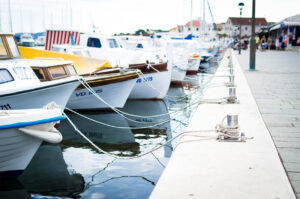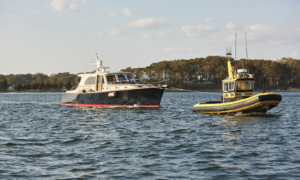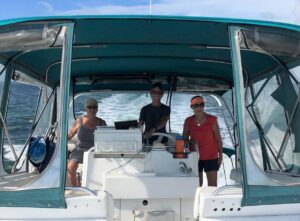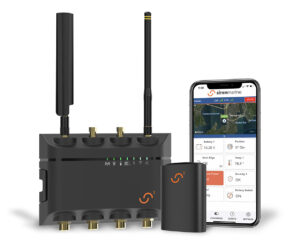When purchasing a boat, beyond buying a material object you are buying into a lifestyle. With just a little bit of studying, it’s easy to see that different types of boats lend themselves to different uses. But to buy the “right boat,” you have to think about this in reverse order. In other words, particular types of boating are best enjoyed on particular types of boats. The more accurately you are able to define how you will use the boat, the more closely you’ll be able to match the boat to your intended use.
FIRST THINGS FIRST
So how do you know how you will use a boat until you get one? Many people buy a boat after being introduced to the lifestyle by a friend or family member. If you decide to join them in their type of boating, you’re likely to buy a boat similar to theirs, which means you now have the perfect boat to suit your needs! If only it were so easy. Are you sure they had the “right boat,” even if they told you how much they liked it? There is a condition called “post-purchase rationalization.” It is a condition in which someone who has made an expensive purchase overlooks any faults in it in order to justify the purchase. Expensive purchases should involve careful research, and consequently many people who haven’t done enough research are reluctant to admit they made a poor decision. This doesn’t mean you shouldn’t ask people if they like their boats — to the contrary, you need to ask as many people as possible in order to get a decent survey of honest opinions.
Will you be a day boater, rafting up with friends at a nearby beach or anchorage? Will you spend weekends cruising to nearby marinas and towns? Or do you plan extended voyages that include open-water passages? Beyond how you will use the boat, where you use it is equally important. Sea and wave conditions can vary widely between the open ocean of some of our coastal states and unique bodies of water like the Chesapeake Bay, Long Island Sound, or the Great Lakes. Choosing the correct hull shape for your local conditions will mean the difference between enjoying a day on the water and wishing you were still safely tied to the pier. The development of local boat styles like the Down East Lobster Boat, the Chesapeake Bay Dead Rise or the Northwest Salmon Troller speaks to the importance of how hull shapes have evolved for local waters conditions. While these regional examples are all work boats, they have strongly influenced pleasure-boat design.
IMPORTANT QUALIFICATIONS
The general process of choosing your boat is not exclusive to categories such as power versus sail, or subcategories like fishing or cruising. Size and cost are relative, not determining factors. Your decision should be based on style. Spending more money on a larger boat does not mean you bought the “right boat.” Small boats have crossed oceans, and good deals on used boats are plentiful. It’s also important to remember that even the “right boat” is not a perfect boat. All boats involve compromise. The goal is to minimize the items that are not in line with your use.
THE PROCESS
Boats are highly emotional purchases, charged with excitement and anticipation. It is difficult to be rational and objective in this process. After you’ve spent some time on a friend’s or family member’s boat or one you’ve chartered, make a list of likes and dislikes. Not just a mental list but a working spread sheet, with features on one axis and boat models on the other. Spend as much time as you can on different styles. Chartering or renting is a great way to do this. List features you enjoy or find useful under various models. Boat shows can be helpful, but they can also be dangerous, because each model is presented at its best in an unrealistic setting. When attending a show, try to attend on the slowest day or be there first thing in the morning. Even then, your only goal should be to identify the models you want to look at again in a non-show setting.
Here is where your worksheet comes in handy or is further developed. How does each model compare against the features you’ve identified as important? Regardless of how much you think you like a boat, how does it measure up against your worksheet? Many people will walk onto a boat at a show expressing interest in that boat, and four different peoples’ criteria for what they want out of that boat might not even be remotely similar. Many people can be dangerously close to buying the wrong boat. If they are serious and capable of buying a boat soon, they are prey to the manufacturer whose boats are displayed best or whose sales person is the most convincing. This is one of the reasons why so many good late-model used boats are on the market — someone who buys on emotion goes out and starts using their new boat, only to find out it’s not well suited to the kind of boating they want to do or to their local waters.
Once you’ve identified a few similar models that fit your criteria, search out owners of those boats and find out how they are using them — not how they like them, but how they are using them. If they are using them the same as you intend, you’re likely heading in the right direction. This is easier than ever today through the internet. Many brands have owners clubs, with websites where you can post questions to owners. Many boat styles have developed clubs for that style, like Trawler Forum, Cruisers Forum, or Saltwater Sportsman for Center Consoles. These website forums are a great resource for finding differing opinions to factor into your decision.
Remember: First things first, define your intended use, then follow the process down a narrowing path towards buying the “right boat.” There is nothing more satisfying than attending a boat show after a successful purchase, knowing that there isn’t a boat there you want more than the one you have.





